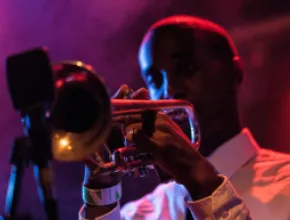Madison and Wisconsin Dells straddle the middle part of Wisconsin, with one offering the culture and bustle of a university town and state capital, and the other offering wide-open natural beauty and an unparalleled assortment of water parks and other amusements.
While both destinations are packed with diversions, they’re also well equipped with sophisticated meeting facilities and amenities.
Madison
Madison has an amazing resume. State capital. Home to the University of Wisconsin. Sits between two scenic lakes. One of the best places to live, writes Money magazine. America’s healthiest city, swoons Men’s Journal. The No. 1 college sports town. Best for cycling, best for raising kids, most romantic city, best walking city...
The national press’ love affair with Madison doesn’t seem to go to the city’s head, though; the Greater Madison CVB just tucks all those awards into a “Madison Rankings” page on its website, and everyone goes back to work.
“We receive awards almost every year,” says Deb Archer, the CVB’s president, listing a few and then getting back to why Madison won.
In downtown Madison, State Street runs east from the University of Wisconsin–Madison campus to the Wisconsin State Capitol plaza, and this major pedestrian thoroughfare is lined with shops and coffeehouses. East of the State Capitol, State Street becomes King Street and the center of an urban-professional enclave, high-end restaurants and stores.
Partly because of the city’s 50,000 college students, Madison has a culture/counterculture balance that’s spawned nicknames like “Madtown” and “Mad City.” On the countercultural side, Madison has more than its share of grocery and housing co-ops; it hosts two massive annual block parties; it’s the home of the hugely popular band Garbage; and it sports more bike lanes than any comparable U.S. city. The cultural side is more traditional, featuring the Madison Scouts Drum and Bugle Corps, the Madison Opera, and several orchestras, ballets and theater companies.
The Overture Center marks ground zero for both the fine and performing arts in Madison. Totaling more than $205 million, the complex includes the Madison Museum of Contemporary Art, which opened in April 2006 and has an elegant rooftop restaurant and sculpture garden, plus an auditorium that seats 200 people. Larger groups may want to sit down in the 2,251-seat Overture Hall, where the Madison Symphony and the Madison Opera perform, or the circa-1928 Capitol Theater.
The University of Wisconsin and Wisconsin state government constantly generate new ideas and bring new people to town, giving Madison a dynamic reputation, but still, Archer says Madison is quite aware of today’s competition for the meeting planner’s dollar.
From a meeting planner’s perspective, Madison wins plaudits for its Monona Terrace Community and Convention Center, located on a site that straddles Lake Mendota and Lake Monona. Opened in 1997, the center’s exterior was designed by Frank Lloyd Wright from 1938–58, although construction didn’t begin until 1994. The interior was designed by Wright apprentice Tony Puttnam as a state-of-the-art exhibition and meeting space, which is reflected in the center’s 40,000 square feet of exhibition space, 14,000-square-foot ballroom and 320-seat multimedia lecture hall. In addition, the center’s bid for an environmentally friendly LEED certification is pending.
The much larger Alliant Energy Center has nine agricultural exhibition buildings, up to 100,000 square feet of exhibit space and its own island, which ESPN used for its Great Outdoor Games in 2004. The center is best-known for the annual World Dairy Expo and for being an easy one-mile walk from the State Capitol.
Rounding out the major facilities in Madison is the Marriott Madison West Conference Center, which sports 292 guest rooms in addition to 50,000 square feet of meeting space.
The city has plenty of other places for attendees to stay and meet, including the Doubletree of Madison, which changed flags from Howard Johnson in April 2005 and simultaneously completed a $4 million renovation of its 163 guest rooms and exterior.
Other prominent Madison properties include the Edgewater Hotel, the Hilton Madison Monona Terrace, the Sheraton Madison Hotel, the Crowne Plaza Hotel Madison–East Towne, and the Madison Concourse Hotel and Governor’s Club, which in November finished renovating 260 of its guest rooms with new bedding, wireless Internet access, lamps, and lighting. Beginning in mid-2007, the property will renovate its remaining 100 Governor’s Club guest rooms, a project that is slated for completion by the end of the year.
Additionally, the Best Western Inn on the Park Capitol Square is renovating its sky- and lake-view Top of the Park meeting space and expects to reopen the venue in late January. The property is also renovating two other meeting rooms, and it finished upgrades to its lobby in 2005 and its casual-dining restaurant last year.
Archer says the Greater Madison CVB is currently pursuing groups of 500 to 2,500 attendees, and that Madison’s value season runs from Dec. 1 to March 1, when regional sports tournaments start heating up the town.
“We know we’ve got really stiff competition and right now it is a buyer’s market, but we have several things going for us: a collaborative, supportive industry between the hotels, restaurants and CVB, and because of the type of city we are, we’re always aware we need to continue to improve and stay fresh,” Archer says.
Wisconsin Dells
North of Madison and midway between Minneapolis and Chicago lies Wisconsin Dells, a strikingly beautiful, five-mile-long sandstone gorge that frames the Wisconsin River and attracts hundreds of thousands of visitors each year. Formed in just days or weeks during a catastrophic Ice Age flood, the Dells’ popularity with vacationers has grown enormously in recent years, turning it into one of the Midwest’s premier attractions and spurring the construction of a pack of water parks.
In fact, the Wisconsin Dells region bills itself as the “Waterpark Capital of the World,” and each water park has its own theme—including the Chula Vista Lost Rios Waterparks, the Mt. Olympus Water and Theme Park, the Noah’s Ark Waterpark, the Timber Falls Adventure Park, and a half-dozen others. Plus, when visitors aren’t splashing—or even surfing in a wave pool—they can go-kart, golf, hike, and horseback-ride to their hearts’ content.
The water park resorts are as competitive as Las Vegas casino hotels and increasingly build all-weather facilities that remain open year-round, even during Wisconsin’s cold winters. The Polynesian Resort Hotel opened the area’s first indoor water park in the mid-1990s, and not to be outdone, the Wilderness Hotel and Golf Resort has a Wild WaterDome, complete with a wave pool and Dual Mammoths family raft-racing, while the Great Wolf Lodge has three indoor water parks with 19 water slides—it’s a balmy 84 degrees Fahrenheit indoors, every day of the year.
Then there are tours of the Dells themselves. The first commercial river tours were given by the Wisconsin Ducks, who used World War II amphibious landing craft (DUKWs) to show visitors the Dells from water level—and still do. Other tour companies include Dells Army Duck Tours and Captain Soma’s Upper Dells Cruises.
Visitors wanting more speed can try Original Dells Experience Jet Boats, Aqua Adventures Jet Airboat Tours or Dells Jet Boat Adventures, all of which treat visitors to thrill rides up and down the river, reaching speeds of up to 40 mph.
Those who want to stick to dry land should give Lost Canyon Tours a look; the firm takes visitors on horse-drawn carriage rides through some tight squeezes in the company’s namesake Lost Canyon.
Visitors and spouses who prefer a quiet afternoon can take advantage of some of the area’s many spa facilities. Sundara Spa and Great Wolf Lodge’s Cameo Spa both have great options for pre- or post-meeting pampering.
The small city of Wisconsin Dells and the village of Lake Delton are central to the Dells area, strategically located between Jordan Lake, Lake Delton, and the Upper Dells and Lower Dells. Both have compact downtowns with familiar resort-area businesses—the fudge shops, the plentiful restaurants and the souvenir stores, and nearly everyone sells sunscreen.
That’s not to say Dells resorts spend all their energy designing the next big water slide. According to Helen Wick, group marketing manager at the Wisconsin Dells Visitor and Convention Bureau, the area’s resorts are every bit as serious about work as they are about play.
“What we have in leisure translates beautifully into business; people extend [stays] to a few days before and a few days after to have family time or time with a spouse or significant other,” she says. “We have a fantastic array of properties that cater to conventions and small meetings, from five to 2,000 in some of our new properties. As far as getting down to business, that’s what we do best.”
Among the many resorts catering to groups is the Kalahari Resort and Convention Center, Wisconsin’s largest convention center. The center features more than 100,000 square feet of meeting space spread over two ballrooms and 35 smaller rooms, with a capacity to seat up to 2,000 attendees.
The Chula Vista Resort touts its riverside location, 100-foot Norway pines and 80,000 square feet of meeting space—plus the ability to seat 1,600 at once in its conference center. As part of a $200 million expansion project that includes a golf course redesign and a new indoor water park, Chula Vista will add a 200,000-square-foot expo center to attract both conventions and regional sports events; the sports facility will be finished in June, and the expo center, slated for completion in April 2008, will be one-and-a-half times the size of the Alliant Energy Center in Madison.
Far from seeing this as a competitive threat to Madison, Wick sees Chula Vista’s move as a win for everyone in Wisconsin.
“We look at it as building critical mass in Wisconsin, to attract the attention of planners from around the world,” she says. “Now we can be looked at, where before we weren’t given a glance. [Planners are] coming back and booking meetings and conventions here because of the quality of the facilities.”
Other resorts with sophisticated meeting facilities include the Great Wolf Lodge, offering 5,700 square feet of function space, and the Ho-Chunk Casino, Hotel and Convention Center, which has 30,000 square feet of function space and a ballroom seating up to 1,100 guests. Ho-Chunk just hosted the 2006 Wisconsin Governor’s Conference on Tourism.
Meanwhile, the Wilderness Hotel and Golf Resort debuted the Glacier Canyon Lodge and Convention Center in December as part of its $150 million expansion. The lodge features its own water park, and the 25,000-square-foot convention center seats up to 500 people for banquets. Other expansion highlights included enclosing its outdoor water pool and installing a roof that allows year-round tanning, and in July, the property will unveil a new golf course.
For More Info
Greater Madison CVB 608.255.2537
www.visitmadison.com
Wisconsin Dells Visitor and Convention Bureau 608.254.7180
www.wisdells.com






